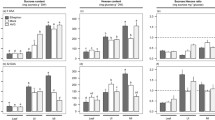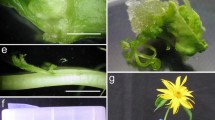Abstract
The four Helianthus annuus (sunflower) inbred lines examined showed different abilities to convert 1-aminocyclopropane-1-carboxylic acid (ACC) to ethylene and different morphological responses to exogenous ACC, however, ACC had no effect on precocious flowering. The greatest effect of ACC was seen with inbred SS405B where it suppressed shoot growth and induced hypocotyl enlargement and callus induction. The greatest response did not correlate with the highest ethylene production. Although each inbred responded differently, callus induction and hypocotyl enlargement observed in hypocotyl segments treated with naphthalene acetic acid and benzyladenine could be partially explained as ethylene-mediated effects of the two hormones. It is suggested that inbred differences could be due to different endogenous hormone levels and/or different sensitivities to them.
Similar content being viewed by others
Abbreviations
- ACC:
-
1-aminocyclopropane-1-carboxylic acid
- AVG:
-
aminoethoxyvinylglycine
- BA:
-
benzyladenine
- NAA:
-
naphthalene acetic acid
References
Abeles FB (1967) Plant Physiol. 42:608–609
Coleman WK, Huxter TJ, Reid DM, Thorpe, TA (1980) Physiol. Plant 48:519–525
Cornejo-Martin MJ, Mingo-Castel AM, Primo-Millo E (1979) Z. Pflanzenphysiol. 94:117–123
Everett NP (1982) In: Akio Fujiwara (ed.) Proc. 5th Intl. Congr. Plant Tissue Culture, The Japanese Association for Plant Tissue Culture, pp. 93–94
Gamborg OL, LaRue TAG (1971) Plant Physiol. 48:399–401
Grady KL, Bassham JA (1982) Plant Physiol. 70:919–921
Huxter TJ, Reid DM, Thorpe TA (1979) Physiol. Plant 46:374–380
Huxter TJ, Thorpe TA, Reid DM (1981) Physiol. Plant 53:319–326
Imaseki H, Kondo K, Watanabe A (1975) Plant and Cell Physiol. 16:777–787
LaRue TAG, Gamborg OL (1971) Plant Physiol. 48:394–398
Lee TT, Dumas T (1983) Plant Physiol. Suppl. 72:39
Lieberman M (1979) Ann. Rev. Plant Physiol. 30:91
Lizada MCC, Yang SF (1979) Anal. Biochem. 100:140–145
Martins-Loucao MA, Rodriguez-Barrueco C (1983) Physiol. Plant. 58:204–208
Miller AR, Pengelly WL (1983) Plant Physiol. Suppl. 72:38
Miller AR, Pengelly WL (1984) Planta 161:418–424
Paterson KE (1984) Amer. J. Bot. 71:925–931
Ricci R (1972) Experimenta 28:597–598
Rose E, Kirkham MB (1983) Plant Physiol. Suppl. 72:38
Stenlid G (1982) Physiol. Plant 56:500–506
Tisserat B, Murashige T (1977) Plant Physiol. 60:437–439
Author information
Authors and Affiliations
Additional information
Communicated by P. Maliga
Rights and permissions
About this article
Cite this article
Robinson, K.E.P., Adams, D.O. & Lee, R.y. Differential physiological and morphological responses of inbred lines to the ethylene precursor 1-aminocyclopropane-1-carboxylic acid by cultured Helianthus annuus (sunflower) shoot tips. Plant Cell Reports 6, 405–409 (1987). https://doi.org/10.1007/BF00272769
Received:
Revised:
Issue Date:
DOI: https://doi.org/10.1007/BF00272769




